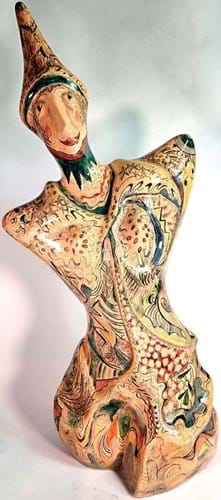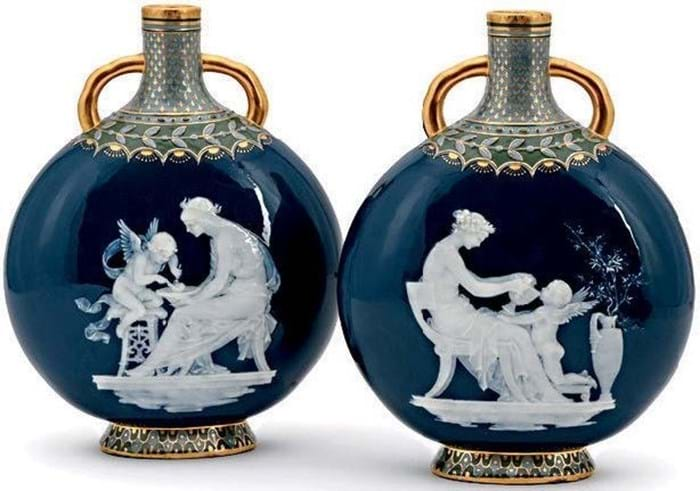1. Anglo-Saxon sword pyramid
The sale at numismatist AH Baldwin & Son on July 5 includes this recent metal detecting find: an Anglo-Saxon gold and cloisonne garnet sword or scabbard mount.
Discovered in 2021, the piece dates to around 580-630AD and is contemporary with similar high-status treasures in the ship burial of Sutton Hoo and the enormous Staffordshire Hoard.
The miniature pyramid of extraordinary craftsmanship has an estimate of £15,000-16,000.
2. Flemish picture

Typical oil by Flemish painter Jan Josef Horemans the Elder (1682-1759), estimate £3000-5000 at Charterhouse Auctions.
This typical oil by Flemish painter Jan Josef Horemans the Elder (1682-1759) comes for sale at Charterhouse Auctions in Sherborne on July 6 estimated at £3000-5000.
Horemans was the leading chronicler of everyday life in Antwerp in the first half of the 18th century and mainly known for these genre scenes. The painting was inherited by the owners from a family member and has spent more than a decade in an attic.
3. Kangxi vases

Pair of Kangxi blue and white soldier vases on later giltwood stands, estimate £100,000-150,000 at Alastair Gibson Auctions.
The term ‘Soldier’ or ‘dragooner’ vase was adopted in the early 18th century to describe monumental vases of the type traded by Frederick Augustus I (1670-1733) elector of Saxony and avid porcelain collector, in return for a regiment of cavalry.
The splendid pair of Kangxi blue and white soldier vases is on later giltwood stands among the highlights of the Asian art sale at Alastair Gibson Auction in Bermondsey on July 5. Standing 3ft 8in (1.12m) high, they are boldly painted with four circular panels of court ladies at leisure on pavilion terraces playing a Qin or looking at a scroll painting.
They have an estimate of £100,000-150,000.
4. Pottery figure

A 3ft 10in (1.15m) high pottery figure titled Ivy made for the 1951 Festival of Britain, estimate £2000-4000 at Potteries Auctions.
This monumental 3ft 10in (1.15m) high pottery figure titled Ivy was made for the 1951 Festival of Britain exhibition.
Based on a concept created by Colonel Sir George Wade (1891-1986), former chairman of the Wade pottery group, and the Potteries entrepreneur Harold Taylor Robinson (1877-1953), it was designed by Colin Melbourne (1928-2009).
The figure comes for sale at Potteries Auctions in Stoke-on- Trent on July 5-8 with a guide of £2000-4000.
5. Minton flasks

Minton flasks, c.1900, estimated at £15,000-25,000 at Dreweatts.
After beginning his career at the Sèvres porcelain factory, Marc Louis Solon (1835-1913) moved to Stoke-on-Trent to work at Mintons where he became the leading exponent of the pâte-sur-pâte technique. His work commanded high prices in the late Victorian period, and it is still much admired today.
This pair of 10in (26cm) flasks c.1900 are decorated in relief with Venus and Cupid vignettes emblematic of food and wine, reserved on a blue ground. They are estimated at £15,000-25,000 as part of the auction of items from Wyld Court, Devon, held at Dreweatts in Donnington Priory, Berkshire on July 19. The sale includes seven lots of Minton pâte-sur-pâte.
6. Russian presentation platter
This Russian carved wood presentation platter is returning to auction at Moore Allen & Innocent.
As reported in ATG No 2594, the ceremonial bread dish had been ‘sold’ in May but the online buyer failed to complete the purchase. The plate will be reoffered in Cirencester on July 5-6. Senior auctioneer Philip Allwood said there was no question marks regarding the authenticity of the dish that has an estimate of £5000-8000.
Made for the presentation of bread and salt to Nicholas II, it is carved with the imperial double-headed eagle and set with silver gilt folkloric roundels and the enamelled coat of arms of the city of Tula. The inscription references ‘the loyal peasants of Tula’ and the date November 21, 1914.









